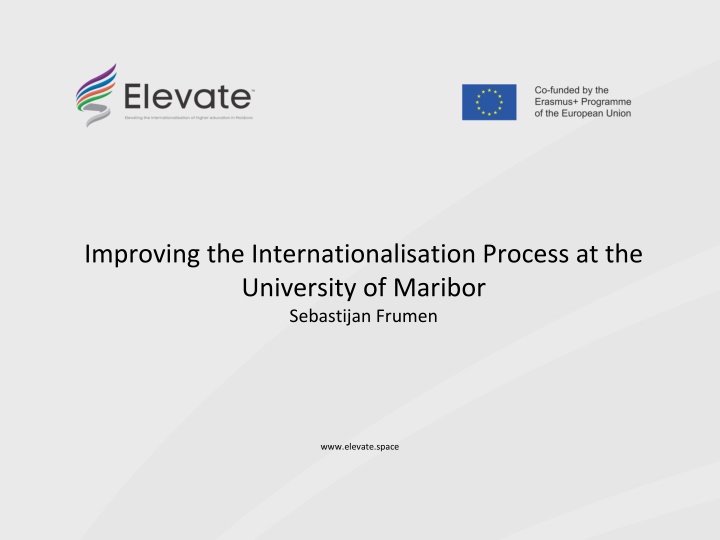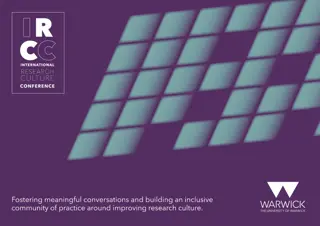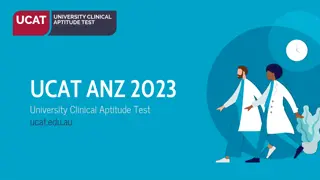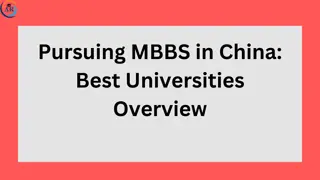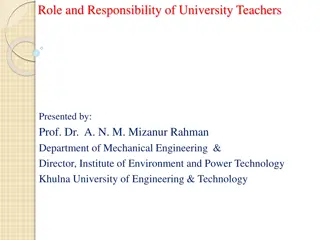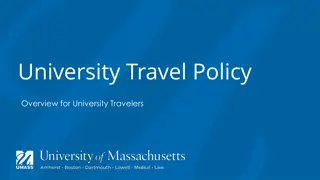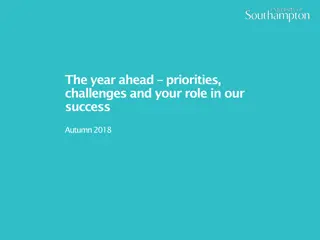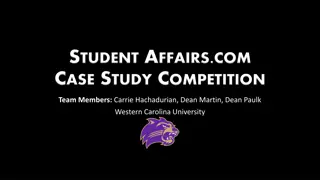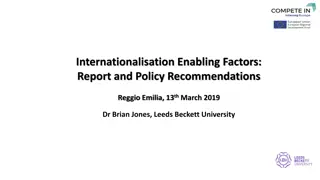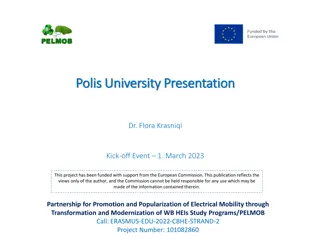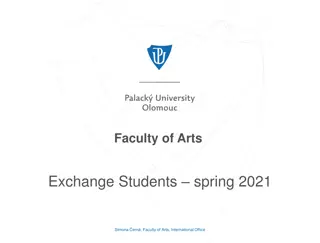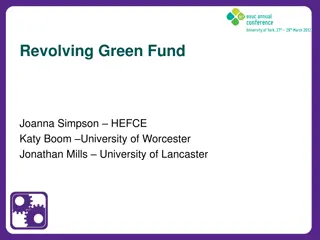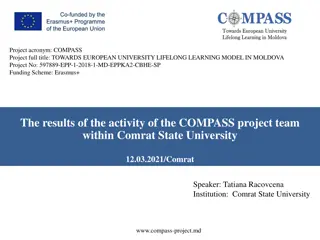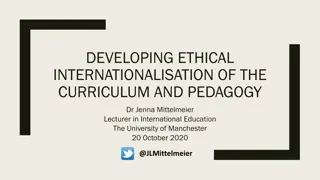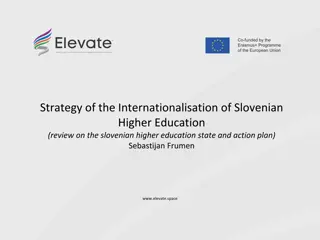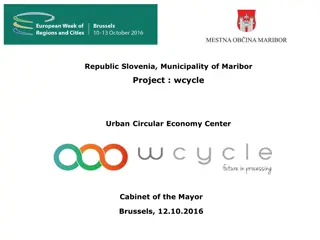Enhancing Internationalisation at University of Maribor
The University of Maribor in Slovenia is prioritizing internationalisation through strategies aimed at integrating into the global higher education area. With goals aligned with national higher education programmes, the university seeks to enhance quality and collaboration through various initiatives.
Download Presentation

Please find below an Image/Link to download the presentation.
The content on the website is provided AS IS for your information and personal use only. It may not be sold, licensed, or shared on other websites without obtaining consent from the author.If you encounter any issues during the download, it is possible that the publisher has removed the file from their server.
You are allowed to download the files provided on this website for personal or commercial use, subject to the condition that they are used lawfully. All files are the property of their respective owners.
The content on the website is provided AS IS for your information and personal use only. It may not be sold, licensed, or shared on other websites without obtaining consent from the author.
E N D
Presentation Transcript
Improving the Internationalisation Process at the University of Maribor Sebastijan Frumen www.elevate.space
1. 2. 3. University of Maribor = 17 faculties, University Library, Student Dormitories Maribor Second largest (public) university in Slovenia 14.300 under- and post-graduate students in the academic year 2016/17 (10.213 undergraduate, 4.036 postgraduate) Educating for BA, MA and PhD 184 under- and post-graduate study programmes (78 undergraduate study programmes: professionally oriented and academic programmes, 70 MA programmes, 35 PhD programmes) Teaching staff: 1.084, Administrative staff: 670 (2016) 4. 5. 6.
Internationalisation as a Tool for Quality Development at the University of Maribor 1. The University of Maribor approached the formulation of an international institutional strategy with its own priority guidelines in 2013 (before the national strategy on internationalisation has been adopted). Following the Resolution on National Higher Education Programme 2011 2020, it aims to integrate Slovene higher education into the global higher education area by 2020. 3. The objectives of the proposed strategy of the University of Maribor are in line with the objectives of the National Higher Education Programme 2011 2020: contributing to the creation of the European Higher Education Area, cooperation with neighbouring regions and the most developed countries from various parts of the world; conducting both teaching and research in cooperation with foreign institutions, higher education teachers, researchers and students; increasing the number of joint degree programmes conducted in cooperation with foreign institutions (priority will be given to postgraduate programmes). 2.
Internationalisation as a Tool for Quality Development at the University of Maribor 4. The University of Maribor will follow national standards laid down in the National Higher Education Programme 2011 2020: 20 % of mobile graduates by 2020 (short-term mobility); a minimum of 10% of exchange students for the entire duration of study by 2020; one fifth of doctoral students studying under joint degree programmes conducted in cooperation with foreign universities by 2020; a minimum of 10% of foreign nationals among higher education teachers, researchers and other employees in higher education by 2020.
Some Issues on Internationalisation in Slovenian Higher Education 1. Resolution on National Higher Education Programme 2011-2020: internationalisation as one of the key areas of further development for the sector 2. Strategy for internationalisation of Slovenian higher Education (SHE) 2016-2020: Adopted in July 2016 by the Government of the Republic of Slovenia SHE shall become a part of the global HE area by 2020 Despite positive trends in recent years, Slovenia still lags behind the OECD and EU averages in the international comparisons of mobility The strategic plan of the Ministry of Education, Science and Sport focuses primarily on the opening of the higher education and scientific research area The strategy is focused on five key areas: international mobility, openness of institutions towards the international environment, high quality international scientific research and development cooperation, promotion of intercultural competences and a focus on targeted priority regions and countries, as weel as the ongoing promotion, support and monitoring of the strategy Daring action plan for the period 2016-2018, within which we are pursuing 25 objectives and over 50 measures with a total value of 57 million, is already being implemented
1. Mobility outgoing and incoming numbers: Student mobility 800 700 664 700 584 600 524 500 407 363 363 400 300 300 200 100 0 2012/13 2013/14 2014/15 2015/16 Incoming mobilnost (Erasmus+, Ceepus, Mundus) Outgoing mobilnost (Erasmus+, Ceepus, Mundus) 2. In 2013 there was 2.370 Slovenians, enroled into study programmes all over the world. Most of the students, are studying in Austria (28 %), Italy (11,2 %), Germany (11, 2 %), USA and Netherlands. International students coming in full study at the University of Maribor: 645 Full study abroad: Slovenian students going out full study abroad (info only on a national level): 700 587 581 600 500 400 335 310 297 295 292 284 300 200 100 0 2014/15 2015/16 2016/17 Full study at the UM - EU Full study at the UM - non-EU TOTAL
Student mobility 3. Faculties of the University of Maribor recognize study obligations according to provisions of the Learning agreement; no difficulties were perceived. 4. Study obligations are recognized according to European credit system ECTS 5. Measures for increasing mobility at institutional level: Active professors encouragment of students for mobility participation from the first year of undergraduate study on (informing students, workshops on mobility). Carrying out individual courses in a foreign language in collaboration with foreign students and increase of guest lecture of foreign teachers. Establish a system of systematic quality assurance of practice for our students abroad and foreigners in Slovenia (practice basis). Helping students perform a quality mobility (establishing a web page, collecting students experiences) Assuring language and culture courses (English, German, Spanish, Portuguese at various levels) Establishing strategic partnerships Increasing mobility promotion
Academic mobility 1. Mobility Foreign staff coming in 157 161 TOTAL 145 108 72 67 Incoming Administrative Staff 59 52 85 94 Incoming Teaching Staff 86 56 0 20 40 60 80 100 120 140 160 180 2015/16 2014/15 2013/14 2012/13 2. Mobility Slovenian staff going out 160 142 136 134 140 130 120 104 95 100 84 72 80 62 52 60 38 35 40 20 0 2012/13 2013/14 2014/15 2015/16 Outgoing Teaching Staff Outgoing Administrative Staff TOTAL
International study programmes 1. In 2016 the higher education registry contained 31 international joint study programmes: 2. According to data of the Slovenian ministry of higher education, there are 175 study programmes carried out in English (academic year 2016/17): 23 BA 77 MA 75 PhD 3. Data collected among Slovenian universities show that in 2013 three Slovenian universities carried out 536 courses in a foreign language (366 at UL, 86 at UM and 84 at UP).
International study programmes Challenges: 1. Slovenian higher education institutions report that accreditation procedures of international joint study programmes in Slovenia are too complicated and last too long. Language in slovenian universities is slovenian (legislation): 2. Article 8 of the Higher Education Act states: If a higher education institution is performing a public service, foreing language can be used for study programmes of foreign languages, parts of study programmes, if foreign higher education teacher carry them out or if a greater number of foreign students if enrolled, study programmes, if the higher education institution also carries them out in Slovenian language. However, the ministry in charge endeavors for improvement in this field with different actions. One of them is the call for improving the internationalization process of Slovenian higher education; more on the topic follows.
International research and events 1. 2. Research is the cornerstone of scientific and artistic excellence and high-quality teaching. In 2012, the University of Maribor adopted the Research and Development Strategy with the vision of becoming a research university, recognized for its scientific and artistic achievements. Study programmes of its 17 faculties are based on its research and scientific fields. Important part of its mission is the transfer of accumulated knowledge into the environment. The University of Maribor encourages the establishment of interdisciplinary teams of researchers for joint research and other projects, involvement in international projects and integrations and involvement of students in research and project work. It works towards achieving optimal material conditions, usage of top research equipment and for the integration with the economic and social environment. The special attention given to the transfer of knowledge into the economy was recognized internationally as according to the Times Higher Education World University Rankings for the year 2016/2017, the University of Maribor was ranked as the best university in Slovenia and its wider southern region. Same results are continuing in the year 2017 and 2018 UM is the best slovenian university according to the Times ranking skale. What makes us proud? 3 slovenian researchers in Slovenia are on the highly cited researchers list and they are all from the University of Maribor (Clarivate analytics). 3. 4. 5. 6. 7.
International research and events Research and development in numbers (data refer to 2015): 1. National research programmes, projects and other activities in cooperation with the Slovenian Research Agency: Over 1000 researchers 109 research teams 54 young researchers 48 research programmes (in 31, the University of Maribor is the leading partner) 27 basic, 12 applied, 2 postdoctoral, 13 target research projects 45 bilateral research projects 2. Contractual partnership in EU frame programmes: 121 3. Other international research projects (ERA_Net, Eureka, COST): 44 4. Development projects, financed either from European or other funds: 65 5. Projects of cooperation with the economy: 203 6. Number of students included in research and applied projects: over 700
A project of the Ministry of Education, Science and Sport for improving the internationalisation process of Slovenian higher education 1. In 2016 the Ministry of Education, Science and Sport published a call for improving the internationalization process of Slovenian higher education. Its goal was to improve the quality of processes leading to a more open and connected Slovenian higher education regarding an international evironment. 2. The goal of the call is cofounding the higher education institutions supporting activities in the field of individuals' mobilities: Establishing an information point for foreign students and teachers Orientation days for foreign students Slovenian language and culture courses for foreign students and teachers Composition and test performance of a preparation module for foreign students Special activities for including immigrants and different aspects of the internationalization home Training of Slovenian higher education teachers for development of intercultural and other competences of Slovenian and foreign students Training of Slovenian higher education teachers for teaching mixed groups of Slovenian and foreign students Course/courses or parts of course/courses adaptation in study programmes enabling a parallel realization in a foreign language process at 3. With the stated call and other mechanisms the ministry realizes the action plan of improving the internationalization process of the Slovenian higher education environment.
The University of Maribor joined the project with approved founds of 281.000 . Between 2016-2017 we commited to: 1. Establishing an info point for foreign higher education teachers and students (development of web applications in a foreign language, upgrading the university information system, informational and promotional material in a foreign language, promotion of study abroad) 2. Organizing orientation days for foreign students (cultural preparation, orientation days, welcome reception) 3. Organizing Slovenian language and culture courses for foreign higher education teachers and students (Slovenian language courses, workshops on Slovenian culture and society, ellective course within study programmes 4. Organizing activities for including immigrants 5. Organizing various trainings for Slovenian teachers on development of intercultural and other competences and for teaching of groups that include Slovenian and foreign students. 6. Organizing adjustment of courses enabling a parallel realization in a foreign language (producing learning materials in a foreign language, parallel realization in a foreign language, foreign language courses genral and spacial) 7. According to the recent analyses we have done majority of planned activities and used most of the planned funds from the project.
